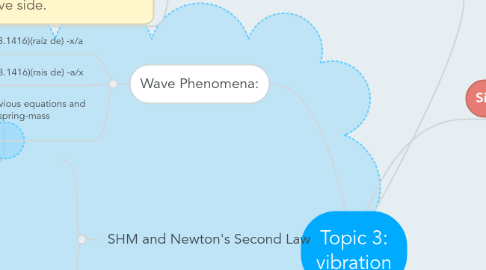Topic 3: vibration
by Ale San

1. Simple Harmonic Motion and Hooke’s Law
1.1. F=-kx/m
1.2. The restoring force will act towards the negative side. If we compress the spring, the mass will move to a negative amplitude but the force will act to the positive side.
2. SHM and Newton's Second Law
2.1. To know the acceleration: a-kx/m
2.2. If we divide the restoring force (F) by the mass (m), we will get the acceleration of the mass.
3. Energy in SHM
3.1. Any time we stretch and release a spring, its potential energy is transformed into kinetic energy and vice versa.
4. Wave Phenomena:
4.1. Period: T=2(3.1416)(raíz de) -x/a
4.2. Frequency: f=1/2(3.1416)(raís de) -a/x
4.3. We can use the previous equations and apply them for the spring-mass ensemble
5. Simple harmonic motion
5.1. Properties: 1.The movement is periodic 2.In absence of friction 3.Produced by a restitution force.
5.2. Angular displacement is the number of oscillations expressed in radians and is represented with the greek letter theta θ.
5.3. Frequency of oscillation or the number of cycles in one second
5.4. Angular frequency or the number of cycles (in radians) per second.
5.5. Amplitude of motion: maximum displacement from the equilibrium position.
5.6. 1 Hz=1cycle/second=1s-1
5.7. Period is the time a body takes to go back to its original position after one full cycle
5.8. f=1/T T=1/f
6. Motion equations
6.1. Position as function of time and Velocity as function time
6.2. Máximum velocity: Vmax=2 (3.1416)= A^k/m (^=raíz)
6.3. Acceleration as function of time: a=-4(3.1416)2f2x


